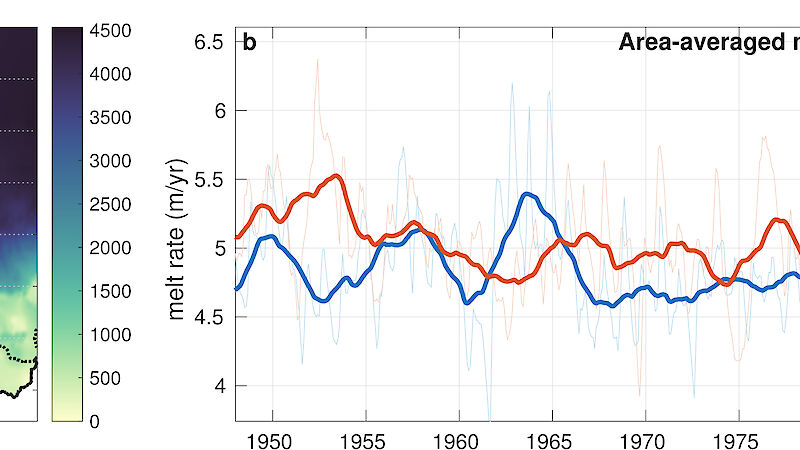The Totten Glacier, near Casey research station, is thought to be the ‘canary in the coalmine’ for climate change in East Antarctica, holding back at least three metres of potential sea level rise. Previous studies have suggested that it is thinning and beginning to retreat.
In a new study I and my co-authors from the Australian Antarctic Division*, CSIRO, and University of Texas, used computer simulations (previously described in Australian Antarctic Magazine 21: 14–15, 2011) to pick apart how and why melting was varying beneath the Totten Ice Shelf.
To do this an ocean model was configured to simulate how warm water flows onto the continental shelf and below the Totten Ice Shelf. The atmospheric ‘forcings’ (factors like wind, heat loss and sea ice formation) for the model were chosen so that it represented a year of normal climate, and this was repeated for 200 years.
We were surprised to find that melting beneath the ice shelf did not just vary annually, but also fluctuated randomly and slowly over multi-year periods, even though we did not force the model with multi-year atmospheric data.
This demonstrates that the ocean is producing long-term internal or ‘intrinsic’ variability, separate from external climate forcings such as the El Niño–Southern Oscillation (a periodic variation in winds and sea surface temperatures).
We compared the impact of this intrinsic ocean-variability-only model, to another model run with the full climatic forcing from 1949–2007. We found that the changes in melting due to intrinsic variability are almost as large as the full climate-forced response (see graphic).
This finding is especially important for the detection and attribution of change in Antarctic ice shelves, where short-term trends are often prescribed as being as a result of a climate change.
Our finding indicates that caution is needed in interpreting changes observed over a short period. Rather than being a result of climate, there is the possibility that they are a natural response in the ocean system.
Any future satellite or field observations of ice shelf and glacier change should consider the internal response of the system, as well as the forced response due to atmospheric phenomena like ENSO or climate change.
Results from this study also predict regions of the Totten Ice Shelf that are less susceptible to natural, intrinsic variability. These locations would be useful for on-ice observations (Australian Antarctic Magazine: 33, 12–13, 2017) because any long-term changes will be detectable above any natural, intrinsic variability.
Numerical models allow us to examine the long-term impact of many different cryospheric processes in a way that you can’t yet with observations. But we need to feed these results back in to field campaigns so that the data we bring back from these remote environments is as good as possible.
David Gwyther
Institute for Marine and Antarctic Studies, University of Tasmania

